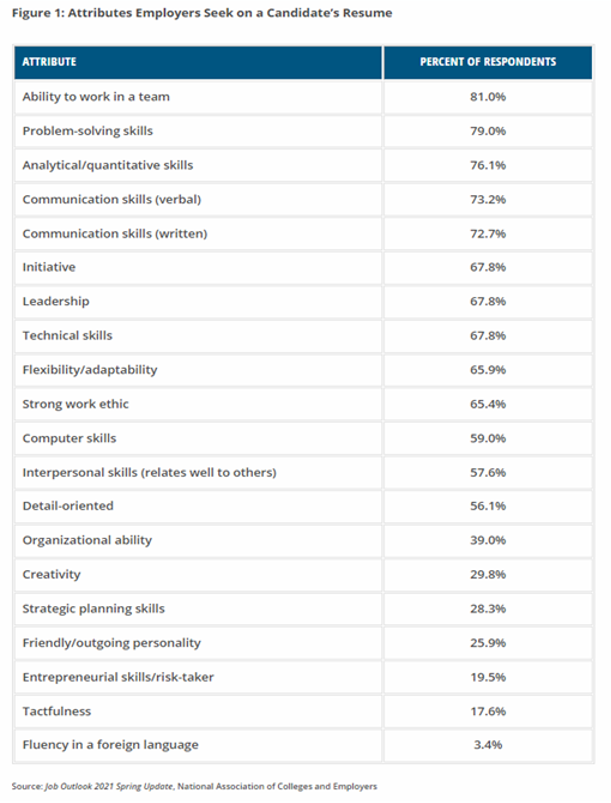Writing the Resume
Below are the sections that will guide you on building a successful resume. The sections will take you over the overall ideas in crafting your resume and give specific examples to get you started. It is recommended to go over the sections from top to bottom.
Purpose
An effective resume grabs the reader’s attention. It connects your skills and experiences with the organization’s and position’s needs. In thirty seconds or less, most employers or organization representatives decide whether to consider applicants for an interview, so your resume's content must be CLEAR, CONCISE, and COMPELLING.
Resume Types
Chronological and Functional Resumes are two typical resume formats. The most commonly used style is “Chronological.”
Chronological:
- Highlights information in reverse chronological order within sections from most recent to least recent
- Most commonly used format as it is easy for employers to understand your timeline
- Allows prioritizing of your sections, so you can highlight your most relevant experiences first!
Functional:
- Highlights information in categories based on commonly grouped skills
- Useful for those with a wide variety of work history, gaps in experience, or those seeking to change career fields
- Tends to be used by more seasoned candidates
- Margins: Top-0.8”-1”; Sides and bottom-0.5”-1”
- Font Size & Style: 10-12 and simple, readable fonts (Calibri, Georgia, Arial, Cambria, Times New Roman)
- Printed Copy: Print copies for in-person interactions (job fairs, interviews) on “resume paper” that can be found at copy centers and office supply stores/sections
- Length: Undergraduate level-1 page; Graduate & PhD-2 pages or more; majors in Education, Nursing and Medicine can have more than 1 page
- Templates: Refrain from using them as they lack flexibility when you want to tailor your resume!
- Order: Heading, objective (if included) and education are first, in that order
- No Pronouns: Do not use first-person pronouns (I, me, my)
- Don't get Personal: Refrain from incorporating personal information such as your age, gender, religion, political affiliation, marital status, ethnicity, visa status or photographs
Your Resume Warehouse
To begin the resume writing process, consider creating a “Resume Warehouse” where you record EVERY position or experience you have had (and will have!) using a Word document, an Excel spreadsheet, or whatever resource works best to capture your information. If you are a newer college student, this may include high school experience. Your “Resume Warehouse” will be useful as you target resumes to meet the needs of specific positions and organizations.
As you brainstorm, here are examples of items to include:
- Social and Professional Affiliations such as teams, clubs, associations
- Volunteer and Community/Campus Involvement
- Leadership Positions
- Class or Design Projects
- Research Experiences
- Practicum or Internship Experiences
- Teaching Experiences
- Study/Travel Abroad
- Honors, Awards, and Scholarships
- Certifications of Licensure
- Languages (indicate level)
- Computer/Technical Skills
- Laboratory Skills/Field Processes
- Presentations and Publications
- Special Interests or Hobbies
- Notable Achievements
KEEP IN MIND: Your “Resume Warehouse” helps you remember key skills and experiences that may be useful to tailor different versions of your resume.
Add the “CORE 4”
For each experience, record these additional “CORE 4” details:
CORE 4
| Company Name | Position Held | Month/Year of Start - Finish | City, State/Country |
|---|---|---|---|
| Silver Cross Hospital | Volunteer | May 2022 – August 2022 | Joliet, IL |
| Purdue Science Student Council | Treasurer | January 2022 – December 2022 | Purdue University |
| Mochas & Javas | Barista | May 2021 – August 2021 | Austin, TX |
The section on “Share Your Experiences” shows how to capture the skills and impactful details for your experiences.
Resumes often include the following sections:
- Header
- Objective
- Education
- Experience
- Honors and Awards
- Activites
View the CCO Handbook for resume examples
Header

Objective

Examples
Objectives

Career Profiles 1

Career Profiles 2

Education
Basic areas to include would be name of institution, location, year of graduation, degree, majors, minors. The GPA often is included but not all the time depending upon the individual’s preference.

Other areas to consider including are:
- Institution(s)
- Location
- Graduation Date
- Degree(s)
- Major(s)
- Minor(s)/Concentration(s)
- GPA (be accurate!)
- Awards, Scholarships
- Course Highlights
Experience

Honors and Awards

Activities

Identify Transferable Skills, Attributes, and Competencies
TRANSFERABLE SKILLS are skills and traits that have been developed and used in one position that can be “transferred” (or taken) into another position. These skills are invaluable and provide a strong foundation for other positions. They demonstrate that you are capable of learning about and doing the job.
“Power Verbs” that help describe these skills can be found in the CCO Handbook.
Attributes Employers Seek in Candidates
ATTRIBUTES are skills, qualities, and traits. According to the National Association of Colleges and Employers (NACE) in its Job Outlook 2021Spring Update, employers sought the following attributes in their candidates:

COMPETENCIES: In its work on “career readiness,”* the National Association of Colleges and Employers (NACE) shares that successfully developing certain competencies prepares college graduates for success beyond college. These competencies are:
| Silver Cross Hospital | Critical Thinking | Leadership | Teamwork |
| Communication | Equity & Inclusion | Professionalism | Technology |
NACE provides useful and detailed examples demonstrating sample behaviors for each of these competencies. Referring to these examples will help you develop bullet points for your resume and share how you have used these competencies. Simply click on NACE’s link to the “What is Career Readiness?” webpage, scroll down, and examine each competency.
* What is Career Readiness? (naceweb.org)
Relate to your tasks/responsibilities
Refer back to your “CORE 4” experiences, reflect upon, and record the TRANSFERABLE SKILLS, ATTRIBUTES, and COMPETENCIES you enriched, developed, and used in these experiences. Doing this will help you understand the value of your experience and how this will make you competitive for future opportunities. You will use this information on your resume as well as in the interview process as you explain your value to employers.
Take one of your experiences, list the TASKS you performed in that position and identify which TRANSFERABLE SKILLS, ATTRIBUTES, and COMPETENCIES might line up with those tasks. For example, if you were a barista, you might record something like this:
| TASKS | TRANSFERABLE SKILLS, ATTRIBUTES, and COMPETENCIES |
|---|---|
| Took money and gave change back to customers, deposited the day’s earnings in bank, closed out a day’s paperwork | Calculate numbers, dependability |
| Wiped tables, cleaned up after customers at end of shift | Efficiency |
| Opened store at 5:30 a.m., finished daily duties before end of shift | Punctuality, time management |
| Worked well with co-workers, trained new employees | Leadership, communication, helpfulness |
| Listened to customer orders and concerns, made quick decisions, got drinks out in a timely manner even though it was really busy, memorized multiple menu items | Customer service, listening, decision making, ability to work in a fast-paced environment, precision |
Now you have the ingredients to MAKE STRONG BULLET POINTS on your resume! Strong bullet points help your reader “see you in action” and understand what value you may bring to the position.
Now it’s time to incorporate those TASKS and TRANSFERABLE SKILLS, ATTRIBUTES, and COMPETENCIES you developed through your experiences into strong bullet points for your resume. Strong bullet points helps your reader “see” and “virtually experience” the value you bring to the position.
You can do this by implementing the following formula:
POWER VERB* + TASK/RESPONSIBILITIES + PURPOSE/METHOD/RESULT = STRONG BULLET POINTS
PURPOSE (why did you do the task?),
METHOD (how did you go about doing the task?), or
RESULT (what happened because you did it?)
HINT: You can include a combination of two of these add on items (for example: purpose and method) in a bullet point. You can even include all three (purpose, method and result)!
For a comprehensive list of power verbs check out the CCO Handbook
Formula Examples: POWER VERB + TASK + PURPOSE/METHOD/RESULT = STRONG BULLET POINTS
PURPOSE
- Observed and analyzed students’ behavior to guide successful classroom instruction
- Performed gear mapping for transmissions to optimize shift patters, fuel economy and available power
- Collaborated with Purdue faculty to increase cultural self-education amongst minority students
METHOD
- Ensured customer satisfaction by listening to orders and delivering product that fulfilled customer specifications
- Collected quantitative infrared imaging using a high- speed infrared camera
RESULT
- Developed new ideas for Exelon’s eFin website which increased traffic flow by 20%
- Performed internal audits on 159 underwriting cases in 3 weeks improving efficiency according to the Audit Board
- Designed and implemented latches for condensation vents to reduce water leakage creating a safer work environment
To help ensure that you present your best written resume to your audience, make sure you edit and proofread it. Below are suggested resources that can assist you:
RESUME REVIEW RESOURCES
- Yourself!
- Read it backwards to catch spelling errors.
- Read it from top to bottom, left to right to catch awkward phrasing.
- Compare it to the position description, organization, and field to which you are applying. Have you neglected to include any pertinent information?
- A trusted friend or advisor
- Tell the person what you hope to achieve with the resume.
- Share the position description so that this person can assess how you “fit” the position.
- The CCO
- For a personalized review of your resume, please schedule an appointment through BoilerConnect.
- Examples: Check out the CCO Handbook for more tips and examples.
Recognize that you own your resume. You know yourself and your experiences best so, while others may have suggestions, this document represents you and needs to sound like you.